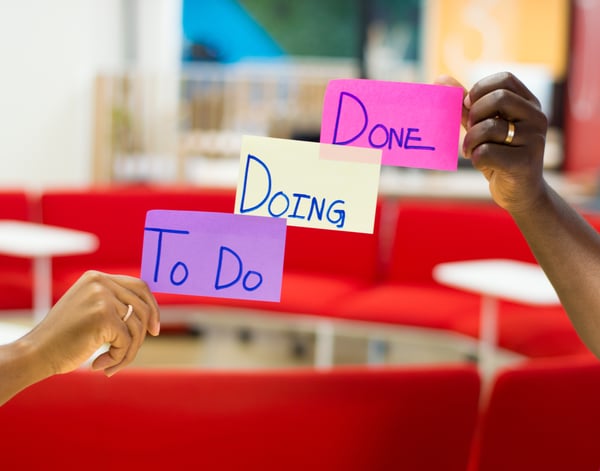In a more open world that has become a global village, it is becoming increasingly difficult to succeed using traditional methods of operation. And the product development sector is far from escaping this constraint.
It is becoming urgent to impose one's product on the market, become more creative and innovative, and leave the paths of classic methods to embrace revolutionary methods.
It is necessary to get out of the fixed plans to adapt to the maximum, in other words: to become agile or to adopt the agile method; that is to say to be able to adapt quickly to unforeseen changes (in a reactive way) and to the new tendencies (in a proactive way) which take shape in its sector while preserving a strategic, operational and human continuity.
And to achieve this, there are five options available to us which are:
- Scrum
- Extreme Programming (XP)
- Rational Unified Process (RUP)
- Feature Driven Development (FDD)
- Rapid Application Development (RAD)
- Dynamic systems development method (DSDM)
Of these options, the first is SCRUM. It's a term borrowed from rugby, but from the perspective of product development, it takes on a whole new meaning.
So, what is scrum from the perspective of product development?
Scrum is a framework for developing complex products. Its creators define it as a "holistic, iterative framework that focuses on common goals by productively and creatively delivering products of the highest possible value."
It is a process that breaks down the separation imposed by traditional precedents and invites all stakeholders to work together without obscuring the sense of organization within the project.
The work organized according to this process consists in dividing a project into "time boxes" called sprints ("speed peaks"). Sprints can last from a few hours to a month (with a median sprint of two weeks). Each sprint begins with an estimate followed by operational planning.
The sprint ends with a demonstration of what has been completed. Before starting a new sprint, the team performs a retrospective.
This technique analyzes the progress of the completed sprint to improve its practices. The development team's workflow is facilitated by its self-organization, so there is no project manager.
In concrete terms, it is a process that relies on teams that operate on the model of a ship's crew in which each link in the chain must play its role perfectly to ensure that the ship arrives safely.
Just as the ship, the officers and sailors each play a specific role without which it would not be possible to deploy the project, so the SCRUM method defines roles to ensure that the project reaches its goal.
Everyone works towards the same goal, making regular deliveries in each sprint and constantly improving the product and the project processes so that we move in the right direction using the most efficient trajectory possible.

What are the Scrum roles?
A crew cannot run a ship unless the roles of each person are perfectly defined. Indeed, there cannot be several navigators, if everyone is in charge of the sails and no one is at the helm, the boat will not go far, and the risks of sinking will only increase.
Scrum, therefore, defines three specific roles, each with a specific function.
The Product Owner will elaborate on the requirements and carry the customer's vision of the final product.
But unlike a classic project manager, he will work closely with the development team to provide it with real expertise in the business domain.
They need a technical profile and are close to the end users, understanding and translating their business functionalities and ergonomics needs.
He is also present to maximize the added value provided by the project team and optimize costs or achieve this, he is responsible for managing the product backlog and for the product prioritization according to the different user stories.
He, therefore, has a particularly important role since his decisions will partly determine the product's quality and the project's final success.
He has no hierarchical power and is ideally located on the same premises as the rest of the team. To use the analogy of a crew, he or she would be the captain, deciding on the direction to take and steering the ship.
Although there is no hierarchical difference, he still has authority since he determines the direction to follow and the constant adjustments necessary to maintain the course.
He or she must also ensure that the entire team can work together in the best possible conditions to reach the journey's end.
The development team will implement the technical solutions and carry out the developments. Ideally composed of three to ten developers, it will work incrementally and deliver a usable and testable part of the final product at the end of each sprint or iteration.
It is very important to understand that the development team has the power to self-organize and is multidisciplinary.
The development team is the crew's heart, which performs the maneuvers so that the ship responds to commands and sails to its destination.
Everyone knows what they have to do and is responsible for the quality of what they deliver. The development team, therefore, does everything possible and puts in place all the tools it may need to deliver an operational product at the end of the sprint.
Finally, the role of the Scrum Master (or SM), which should not be confused with that of a project manager, is to lead and facilitate the development team's work.
He is not there to command and control the project. He or she must ensure that the development team is fully operational and can work in the best possible conditions to complete the tasks prioritized for the current sprint.
He must therefore protect the team from any disruptions that may come from the outside but also facilitate internal communication and dialogue with the product owner.
The Scrum Master will also take care of all administrative tasks and ensure that the Scrum methodology is correctly applied.
Within the ship's crew, the Scrum Master is the Bosco. He ensures that everything is going well on the boat, that the crew can work properly, and helps everyone to know their role and find their place. In short, the Scrum Master is a facilitator within the project team.
The members of a Scrum team are divided into three different Scrum roles, without any hierarchical relationship between them.
The Product Owner will define the requirements, model the product and define the priorities. During iterations or sprints, the development team will realize user stories defined as priorities by the product owner.
Finally, the Scrum Master will ensure that the agile methodology is respected and will facilitate the work of the development team and the communication with the product owner.
All the members of the Scrum team, whatever their roles, are located at the same level, without any hierarchical relationship between them, and work for the project's success.
FAQ
What are the roles in the Scrum framework?
A Scrum team consists of three distinct roles: the Scrum Master, the product owner, and the development team members.
What is the most important role in Scrum?
Product Owner. A product owner is very important in agile project development because the person clearly understands business needs and the expected product.
Which is not a Scrum role?
There are only three roles in a Scrum Team: Scrum Master, Product Owner, and Development Team. No other role is allowed, and there is no exception to this rule.
What are the roles of a Scrum Master?
The Scrum Master is responsible for creating and onboarding project teams, integrating them into the organization, and providing a clear product vision.
